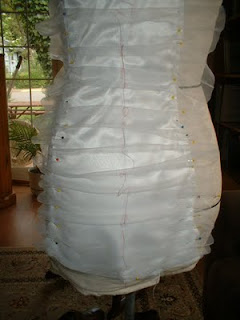Add some pizazz to any basic pattern by adding rows of gathering into the seam allowance with a little bit of draping. If you've never done draping before, this is a great way to get started with it.
For my example, I'm using white tricot over satin on a princess seam pattern. Because tricot is a knit fabric, I can drape this with the grain. If you are using a woven fabric, you should drape on the bias. You will need a mannequin to get the right tension and effect on the overlay.
Step 1: Sew the princess seam, or darts of your base layer. Pin it to your mannequin. Cut a rectangle, on grain, a little bit wider than and twice as long as your base.
Step 2: Using a contrast thread, hand baste a thread the length of your rectangle, on grain. I basted mine exactly down the middle. This thread will help you to stay on grain as you gather up the fabric.
Step 3: Starting at the top, pin the overlay, gathering up the fabric as you go, along the seam allowance on both sides.Keep the gathers parallel to the floor. You should have to pull a bit horizontally to keep the gathers taut. Do re-pin and adjust the gathers until you are satisfied with the result.
Step 4: Trim the excess to match the cut line of your base.
To make it easy to sew it the same way you pinned it, use a contrast thread to tailor tack the overlay where the base has notches. If there are long spaces without notches, add tacks to both the base and the overlay. It's really helpful to have points where you know the two match up.
Step 5: Remove the overlay from the mannequin and use it to cut a second
side. If you will be making this style again, you can make a pattern from the overlay by tracing it.
The center basting now becomes a guide for the grain line, and the tacks show where notches should go.
Step 6: Baste two rows of stitches on all gathered sides. Pin overlays on to the base matching the notches and tailor tacks. Sew overlays on top of the base pieces with a long machine stitch. Press.
Your pattern pieces are now ready to be assembled. Happy Gathering!
Simplicity #1061 Sew Along
Saturday, May 21, 2011
Tuesday, May 10, 2011
Make Mine Sheer!
Personally, I don't care for traditional suit jackets, but I can go for other types of creative layering! The concept behind #1106 began a year ago with the idea of a sheer "jacket" that can double as a shirt. Once it was near the end of the production process, I brought the package cover to exercise class to get the opinion of my friends. The first thing they said is "I don't work with THAT kind of fabric!" Ouch.
Just because you can see through it, don't automatically think the fabric need be "difficult to work with". The two most common sheer fabrics are Organza and Chiffon. Sheers get a bad reputation from Chiffons, which are slinky, slippery, with a soft hand and drape. Organza is the polar opposite, being firmer, easy to cut, and full of good body. In fact, organza is often used in finer apparel as an interfacing, and if used alone, as with the Phantom Jacket, needs no additional stiffening at all for a good shape in your collars and cuffs.
Being woven, both types of fabric will fray, yet they both can take very different types of seam finishes. The most common seam associated with sheers is called a "french seam" in which the seam is sewn in such a way that the cut edge is actually enclosed. There are so very many tutorials on french seams that I won't go into it here, except to say that the best, most professional french seams will be very narrow, less than 1/4" wide. On first glance, the seam will nearly be undetectable. With Chiffon, french seams are nearly the only option. However, with organza a french seam is a nice choice, but not the only one. Other seam finishes - from a simple serged edge, to a hong kong finish - could also be considered.
On the Phantom Jacket, the only seams needing a seam finish will be the back, side, and sleeve seam. Everything else is trimmed and enclosed in a facing. Myself, I used a serger on these seams, cutting them to a narrow 1/4". Now how easy is that? I hope my friends in excercise class might reconsider their opinion on sheers. Not all of them are "difficult"!
The Phantom Jacket and Pant pattern is available this week on Etsy on a "pre-order" status, to be mailed out on Monday, May 16th. Also, I'm offering a 15% discount on all Etsy orders now through May 16. Use the coupon code MOMSR4EVER at checkout:
http://www.etsy.com/listing/73756255/new-sewing-pattern-1950s-retro-jacket
Subscribe to:
Posts (Atom)











